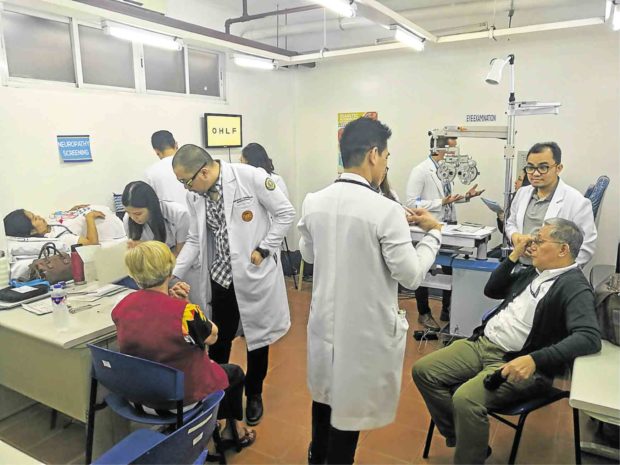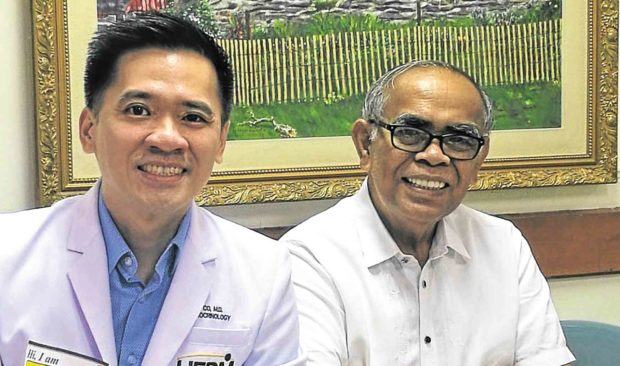
On a humid, rainy Thursday afternoon, doctors at the University of the East Ramon Magsaysay Memorial Medical Center Inc. (UERMMCI) in Quezon City were busy attending to dozens of people who came to the hospital for consultations and to listen to a talk on diabetes.
Dr. JM Co, chair of the UERM Department of Medicine which handles the college and the medical center, was explaining to the audience what diabetes is, and why it’s such a destructive disease:
“It destroys many of the organs in our body. It’s the No. 1 cause of blindness, the No. 1 cause of kidney failure that leads to dialysis and transplants. It destroys or blocks the blood vessels in the heart, in the brain, and in the legs, so that the risk of getting a heart attack or stroke, or leg amputation, is much higher than that of a person without diabetes.”
In layman’s language, Co pointed out how to avoid suffering from diabetes, which, he said, now afflicts 3 to 4 million Filipinos.
“You can control diabetes,” he told Lifestyle after his talk. “Avoid the risk factors: being overweight or obese; and lack of exercise.”
It’s also important, he stressed, to have a checkup: “Get tested before age 40. It’s strongly recommended for all Filipinos at age 40—those who are at low risk, every three years, those with risk factors, it should be every year.”
High blood sugar
Diabetes is a group of metabolic disorders marked by high blood sugar over a long
period.
The three main types of diabetes are:
- Type 1 diabetes (or juvenile diabetes), which results from the failure of the pancreas to produce enough insulin;
- Type 2 diabetes (adult diabetes), which starts with insulin resistance or when cells fail to respond to insulin properly. As the disease progresses, a lack of insulin may also develop;
- Gestational diabetes, or when pregnant women without a previous history of diabetes, develop high blood sugar levels.
Common symptoms are frequent urinating, thirstiness, hunger, extreme fatigue, blurry vision; slow-healing cuts or bruises, weight loss, even when eating more (type 1), tingling, pain, or numbness in the hands/feet (type 2).
Public information
“Diabetes continues to be a major problem. In fact, I would consider it an epidemic now in the Philippines,” said Dr. Joven Cuanang, UERMMCI board of trustees member.
“It’s important to educate the people. A public information service should be sustained, which should really be a role of government as part of the promotion of preventive medicine program.”
But the problem is, Cuanang pointed out, “(the effort) has many gaps. That’s why we decided to put the word out about the Diabetic Center at UERM.”
Cuanang and Co are like a one-two punch leading the UERM team to help as many people control, if not avoid, diabetes.
Cuanang, a neurologist and former medical director at St. Luke’s, finished med school at UERM in 1962. After training at Harvard, he returned to the country in 1969 and started his medical career at UERM.

He formed the neuroscience department and trained neurologists who are now also teachers.
One of his students was Co, now an endocrinologist. After doing residency in internal medicine at Cardinal Santos, Co signed up for a fellowship in endocrinology at St. Luke’s. He went back to UERM in 2008 as faculty member.
Co and Cuanang acknowledged another UERM alumnus, the late Dr. Ricardo Fernando, for his efforts in diabetes awareness and management.
“He trained in the best center of diabetes in the world, the Joslin Center in Boston,” recounted Cuanang. “When he came back to the Philippines in 1969, we formed a diabetes institute (at UERM). He envisioned a center where education and research would be its thrust. He labored very hard.”
Added Co: “Dr. Fernando was a visionary. He knew that there was a coming pandemic of diabetes. He noticed the lifestyle, attitudes of people, the food they eat. He established the Institute for the Study of Diabetes Foundation, which organized fellowship programs in diabetes management.”
Consultations
Co, Cuanang and their team, with support from the UERM board and management, have started retooling the hospital’s diabetes center, initially with free public consultations and advice every Thursday.
“Every day in my clinic, I have a newly diagnosed diabetic patient. It used to be a disease of the rich, kasi sila usually ang overweight. But now, even the underprivileged have it,” said Co.
He’s not convinced yet that diabetes is reversible: “Classically, once you’re diabetic, you’re always diabetic. It takes 10 years for diabetes to develop. So you just can’t reverse all the many changes that led to your blood sugar becoming high.”
Is it okay to not take medication on the first year of being diagnosed with diabetes?
“We recommend all diabetic patients to take medication because the failure rate of lifestyle therapy alone is high on the first year,” said Co.
“Diabetes is a lifestyle disease, although there is also a genetic predisposition, like, if your parents are also diabetic. But mostly it’s due to a sedentary lifestyle—no exercise, too much eating. The worry is that we are raising children who are becoming too fat and diabetic,” said Cuanang. “Stress is also a factor.
Cuanang also referred to Dr. HB Calleja, “a very wise cardiologist,” who said: ‘Heart attack is diabetes.’ He meant that almost all patients with heart problems are diabetics. So, if you control diabetes, it’s possible to control the incidence of heart disease.”
In 1997, Cuanang, then 57, had a heart attack and underwent bypass surgery. “What caused it? My eating. Bagnet!”
The Ilocano doctor said with a laugh. “And stress, because of my medical practice, I had high blood pressure. But mostly it was diet at the time. That was the turning point. I had to take a look at my lifestyle.”
He added that, as a neurologist, “Stroke or brain attack can also be caused by diabetes. Diabetes, hypertension, hyper-cholesterol, these are all lifestyle diseases.”
Lifestyle changes
So, what to do?
“If you have diabetes, treat it,” said Co. “Make lifestyle changes. Engage in appropriate physical activity. Get back to your ideal weight if overweight. Avoid smoking. Avoid alcohol.
“Get proper medical treatment. Monitor your blood sugar levels.”
To know if you’re diabetic:
- For nondiabetics, after a fasting of 8-14 hours, blood sugar level should be less than 100.
- 100-125 is prediabetic
- 126-above is diabetic
The doctors themselves take their health seriously.
“I jog,” said Co. “I take the stairs. I’ve never taken the elevator since I started studying at UERM. Kahit na we had classes on the sixth floor, second floor, stairs talaga ko.”
Cuanang revealed: “I’m almost 80. I don’t drink except during socials. I don’t smoke. I get a good seven hours of sleep. I exercise three times a week—walking, calisthenics or swimming every now and then. I take my medications religiously.”
As to the current belief that eating white rice can lead to diabetes, Co said that “while there are fad diets that limit carbohydrates, we don’t have enough studies for these yet. They may be promising, but it’s hard to make a recommendation until the long-term data comes out.”
He stressed red meat has been associated with higher risk of colon cancer. “Limit red meat, eat more fish and vegetables. If you eat meat, it should be lean meat.”
Asked what he eats, Cuanang, said: “I eat very sparingly. I have a full meal at dinner with lots of vegetables.”
There’s a method to eating wisely, he said: “You eat only up to the point when you feel like you’re getting full. That’s the signal to stop. You have to have discipline. My mom taught me how to chew food 30 times before you swallow it. When you do that, you control your satiety centers.”
The UERM Diabetes Center offers free public consultations every Thursday, 1-4 p.m. UERM Medical Center, 64 Aurora Blvd., Quezon City; tel. 7150861; Facebook:@UERMDIABETES; email diabetescenter@uerm.edu.ph













































